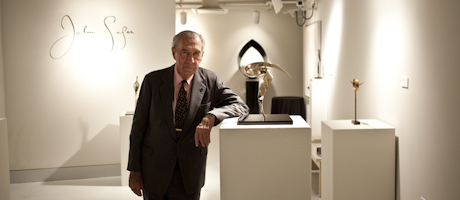By Menachem Wecker
About 35 years ago, John Safer completed a propeller-shaped sculpture he had carved from a piece of gray tinted polymethyl-methacrylate (also called Plexiglas or Lucite). “It had a form I liked, but I couldn’t figure out how to display it,” he says.
After putting it aside for a while, Mr. Safer, A.A. ’46, B.A. ’47, decided one day to mount it in an oval-shaped metal frame. The new form resembled the mathematical symbol for eternity, so he titled it Limits of Infinity.
It wouldn’t do to have just a single work about infinity, so Mr. Safer, who had been spending time looking at landscapes by the 19th-century American painter James Abbott McNeill Whistler at the Freer Gallery of Art, decided to make several versions of the sculpture.
Just as the England-based Whistler, who worked before, during and after the Impressionists, studied the ways changing lights affected landscapes, Mr. Safer used different colors of Lucite to form two larger versions of Limits of Infinity. Former President Gerald Ford gave the first one to King Juan Carlos of Spain, and it now stands in Zarzuela Palace. The largest one, which is all bronze, stands in the rose garden near University Yard.
Mr. Safer visited campus last Thursday and joined GW President Steven Knapp at the opening of an exhibit of 21 of Mr. Safer’s works at the Luther W. Brady Art Gallery. The exhibit closes Oct. 29.
Two of Mr. Safer’s sculptures, not including Limits of Infinity, are permanently installed on campus. Golden Quill (1996), which depicts a life-sized quill, is in the entrance to Gelman Library, and Null Space (1979), a tall, twisted and highly polished work which Mr. Safer recently donated to the university, was installed at the F Street House on July 29 and unveiled in a private ceremony last Thursday.
Mr. Safer says he chose the title of the first piece from the line “Reserve their character with golden quill” in Shakespeare’s 85th sonnet. Though he attended GW about the same time as Melvin Gelman, Mr. Safer says the two were only casual acquaintances at the time, and became friends later on.
When then-GW President Stephen Joel Trachtenberg asked if Mr. Safer would contribute a second sculpture for the library, Mr. Safer agreed to donate Golden Quill, because “it was created with the concept of signifying the majesty and power of Shakespeare’s words.”
According to Mr. Safer, Null Space is “more abstruse and abstract.”
“I wanted to emphasize that this work, more than most sculptures, not only is a shape that occupies a given space but also reaches out—at least I think it does—and manipulates the space around it,” he says.
When he created Null Space, Mr. Safer was trying to show the interconnection between music and sculpture.
“Since the music that means the most to me is that of Johann Sebastian Bach I used an approach to sculpture which I felt was similar to that of Bach,” he says. “I started with a tonic note, then expanded out from that point, creating harmonies and discords, themes and counterpoints, and then eventually returned to the starting point of the tonic note with the hope that I had resolved everything into a harmonious whole.
“I realize that’s quite a bit to expect from a motionless piece of metal,” he admits, “but that’s what I had in mind.”
Mr. Safer says he hopes that Null Space will enhance Dr. and Mrs. Knapp’s lives, as well as the lives of the students and visitors who visit their house.
“I tried to create beauty where there had been none before. I tried to create sculptures, which at best, I hoped, would inspire others,” said Mr. Safer at GW’s 2009 Commencement ceremony where he received an honorary doctor of fine arts.
Not only has Mr. Safer created beauty, but the titles of many of his works are inspirational: Promise, Bird of Peace, Caring, Serve, Ascent, Ode to Joy, Unity and Soaring.
Many of Mr. Safer’s works have aerial references, according to Lenore Miller, M.F.A. ’72, director of university art galleries and chief curator. “John Safer has always been interested in flight,” she says. “His work is very reflective.”
Ms. Miller, who has visited Mr. Safer’s home and studio in McLean, Va., says the exhibit will replicate the manner in which the artist’s works are installed in his studio.
“We are borrowing his pedestals,” she says. “Drawing inspiration from the way Mr. Safer displayed works by the late American painter James Twitty in his gallery, we are including works by James Twitty from GW’s permanent collection.”
Mr. Safer has said he will donate 40 percent of any sales from the Brady Gallery show.
“I really don’t know of a better cause than education to which anyone could contribute,” he says.
Mr. Safer, who was “greatly honored” to receive a doctorate from GW, says he experienced a “warm feeling of nostalgia” returning to campus for the exhibit.
He says he was happy to contribute his other works to GW’s campus, because he and Mr. Trachtenberg shared the vision that “a university campus should have an aesthetic ambience to exist in consort with the academic environment.”
During Alumni Weekend, alumni will have a chance to view the Brady Gallery show and to meet Mr. Safer on Oct. 2 from 4 to 6 p.m. The Luther W. Brady Art Gallery is also open Tuesday to Friday, 10 a.m. to 5 p.m.


